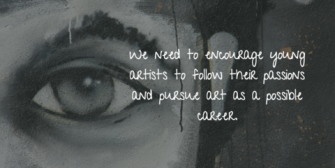
Guest post by Douglas W. Green, Ed.D., and Lena Green
Does your child show talent and passion for art? Are you wary of paying for art school?
Then take a look at any media: television, print media, or the internet. There you will see content that was created by an artist.
Anyone with quality art training and skill can get work.
While it might not all be personally fulfilling, doing what the boss wants still pays. Ideally, this fits with your passion, but if it doesn’t, you can follow your passion after hours. I speak from experience as I raised an artistic child who has had full-time work ever since she graduated from Pratt Institute in Brooklyn, N.Y. in 2006.
A Passionate Kindergartner
In kindergarten, my daughter stated clearly that she wanted to make cartoons. Art was a field that my wife and I knew little about so we had some work to do. We weren’t excited about the idea, but we did believe that we should support whatever our child was interested in.
We believed that we should encourage and never discourage.
We bought abundant art supplies. We went to countless museums. We also let her watch more cartoons on TV than a lot of parents. She drew on my computer, but mostly she drew things on paper.
Upstate New York gave us lots of chances to build things out of snow. Most were things other than snowmen. Halloween represented an annual opportunity to design and create a costume from scratch.
When she was 8, she did the cover for our homemade Christmas card and still does. We were tolerant of paper mâché projects and other messes. She painted the woodwork in our living room and redid a bathroom.
In middle school, we hired local artists to give private lessons.
Art In High School
Course requirements in high school made it difficult to fit in art classes. She gave up study halls to take one class. I persuaded several art teachers to let her take a second course every other day opposite physical education.
Even though she was in class half time, she completed the course requirements and got credit. She took AP art history half time and got a 4 on the AP exam.
Taking other AP courses helped her avoid some nonart requirements in college and provided the opportunity to take more art courses. This allowed her to minor in art history as an artist can’t know too much about art. In high school, most of the students in the art classes were far less serious and dedicated. Many also had poor attendance. This allowed the teachers to give her more attention which they enjoyed.
At the time (2002), the art department didn’t have computers. Instead of teaching software, they taught art. Today many schools offer courses that teach students how to use software like Photoshop. I would rather see schools offer software courses online. I found an online Photoshop course that my daughter finished in four weeks. Her work in high school also earned a $9,000 a year merit scholarship.
Portfolio Production & Getting Naked
Quality art schools like Pratt require your best work in a portfolio. Students should start this process when they enter high school as this is not something you can throw together quickly. Schools like to see drawings from real life. Be sure to look for summer art programs and don’t rule out those aimed at adults.
They also like to see drawings that include the human body with and without clothing. A friend sent her daughter to art school and learned that she was shocked when first faced with a nude model. I decided to get that shock over with before my daughter left home. I booked sessions at our community college and a local art gallery. I accompanied her, and it turned out to be no big deal.
There are many different types of art majors at schools like Pratt. My daughter majored in 2D animation, but there were at least a dozen different specialties presented at her graduation. Some offer more career opportunities than others. Keep this in mind as you pick a specific art major. Freshman year should offer a variety of general courses, but by sophomore year, you should be ready to focus.
Reel Time
When it’s time to look for work, you need to put together another type of portfolio, which should be online. For motion work, it’s called a reel. It is a short video that contains clips of your best work. Working artists continually update their reels in case they want to apply for a better paying job or one more to their liking.
Here is the link to my daughter’s current reel: https://www.valmontgod.com/. Click on her name to watch 1:35 of her best work since entering the professional creative world in 2006.
In her reel, she did all of the work that makes things move. Some of the content was done by other team members. This makes an important point often lost in high school. For some teachers, collaboration is cheating. In the real world, very little gets done by individuals.
Recently I Skyped my daughter and three of her colleagues into an art room at a local high school. One point that came across strongly was that if you want to make it as an artist, or in just about any career, you need to be able to collaborate. You also need a growth mindset so you are determined that the learning will never end.
So if you know young persons interested in art, please share this advice with them and their parents, along with your encouragement.
Twitter Accounts: @DrDougGreen - @ValmontGod Blogs: https://DrDougGreen.Com https://ValmontGod.Com Book: Teaching Isn't Rocket Science, It's Way More Complex: What's Wrong with Education and How to Fix Some of It. *Photo created with Pablo.com